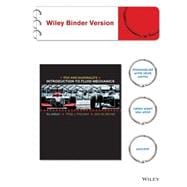Fox & McDonald’s Introduction to Fluid Mechanics 9th Edition has been one of the most widely adopted textbooks in the field. This highly-regarded text continues to provide readers with a balanced and comprehensive approach to mastering critical concepts, incorporating a proven problem-solving methodology that helps readers develop an orderly plan to finding the right solution and relating results to expected physical behavior. The ninth edition features a wealth of example problems integrated throughout the text as well as a variety of new end of chapter problems.








